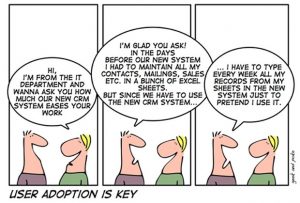Business Intelligence
Boost BI User Adoption with Embedded Analytics

You lay lazily, your scruffy hair half submerged in the marshmallow-like curvature of your pillow, lethargically following the steadfast progression of a solitary ant along the windowsill.
You’re sprawled across your arm; it’s numb. But the mere thought of moving is too much. After all, it’s Sunday, and you’d need a good reason to disentangle yourself from the bed sheets. Without motivation, it’s pretty easy to just let the day pass by in an unproductive haze.
I think many companies have a similar disposition towards embedded Business Intelligence (BI) – the integration of a reporting and analytics module within an existing software application.
I’m not suggesting that most organizations considering integrating analytics functionality within existing applications and business processes are somehow trapped within a permanent state of Sunday slothfulness. But, I am proposing that unless supplied with appropriate motivation, inaction will triumph over action.
And the best type of motivation? Clearly discernible benefits.
Aberdeen on Embedded BI Benefits
The Aberdeen Group’s Data Management for BI: Fueling the Analytical Engine with High-Octane Information study underscores the growing demand for embedded BI capabilities, reporting that organizations are struggling to effectively utilize increasing data volumes. The report found that, in 2012, the average organization is experiencing a 41 percent year-over-year increase in data volumes, from an average of 15 different data sources.
More importantly, another Aberdeen report – Embedding BI in Enterprise Applications: Magnifying the Analytical Impact – found that organizations using embedded BI enjoyed a number of notable benefits, including:
- A 20 percent year-over-year increase in operating profit, compared with 10 percent for average organizations
- A 19 percent year-over-year increase in organic revenue, compared with 12 percent for average organizations
- A 16 percent year-over-year increase in operating cash flow, compared with 9 percent for average companies

According to research and analyst giant Gartner, less than 30 percent of the potential users of organizations’ standalone BI tools use the technology. Other firms estimate that BI adoption rates for standalone BI solutions are even lower, languishing between eight and 20 percent.
Comparatively, Aberdeen’s Embedding BI in Enterprise Applications: Magnifying the Analytical Impact report found that 60 percent of those embedded BI users surveyed came from organizations with a “strong analytical culture”, where data-based decision-making is highly valued.

- Higher perception of BI ease-of-use
- Higher perception of information relevancy
- Higher perception of reporting and analytics accessibility
TDWI on Embedded BI
So what are the underlying reasons for such embedded BI benefits?
Respected analyst and researcher, Wayne Eckerson, argued in the TDWI paper Embedded Analytics: Closing the Loop Between Operational and Analytical Applications that “the best way to simplify and operationalize BI is to embed it directly into operational applications and processes that drive the business.”
Eckerson went on to suggest that much of the future of BI, and its continued success in terms of user adoption and pervasive deployments, is reliant on embedded BI.
“Rather than using standalone BI toolsets that require setup and training, business users will leverage embedded BI functionality that is an integral part of a larger application or package,” wrote Eckerson. “Users will no longer shift software contexts when moving from operational processes to analytical ones.”
Eckerson intimated that because users of standalone BI solutions are required to exit operational applications in order to access relevant reports, then subsequently re-enter the operational application to take appropriate action based on the intelligence garnered from the BI tool, their productivity is reduced.
Eckerson said reduced productivity was a result of two key factors:
- Having to exit, enter and re-enter different applications breaks user “train of thought”; and
- Having to view analytical information via a separate BI application means the data is not viewed in its optimal context.
Eckerson suggested that these obvious impediments to the effectiveness of business analytics would see many organizations and software developers turn to embedded BI.
“In the future, users will gain analytic insight within the context and flow of a single, process-driven application,” wrote Eckerson. “At this point, BI simply slips into the background of a primary application that users use to do their jobs. Users may no longer realize that they’re using distinct BI tools to access and analyze information.”
However, as Eckerson noted, embedded BI is a compliment to, rather than a replacement for, standalone BI software.
“Embedded analytics will not replace standalone BI tools,” wrote Eckerson. “Rather, embedded analytics will make the functionality offered by such toolsets more readily available. By embedding BI functionality within operational applications and processes that drive the business, embedded analytics will make BI more operational, easier to use, and pervasive.”
There are a multitude of potential benefits that can be attained via embedding reporting and analytics functionality into existing operational applications and processes.

- Boost BI user adoption: Embedding BI functionality into an existing software application enables users to access and interact with those analytical features within a framework that they are already accustomed to, thereby increasing ease-of-use and lowering resistance to adoption. Not only does replicating the look and feel of the core application reduce barriers to adoption, embedding BI into an existing operations-specific application also ensures the relevancy of the analytics produced for the user base.
- Boost BI effectiveness: Embedded BI can directly link reporting and analytics capabilities to operational processes to help improve the immediacy and relevancy with which users attain data-based insights, hence assisting to directly link insight to action.
- Support pervasive BI: Embedded BI enables more pervasive use of reporting and analytics – and facilitates and underpins the development of an organizational culture based on fact-based decision-making – because BI insights are delivered via the applications and processes that users already utilize on a regular basis to perform their job. Therefore, embedding analytical capabilities into existing applications and processes is an effective way to deliver BI to a wide range of business departments without having to purchase a standalone BI platform to meet the requirements of each user group.
- Build a bridge between information and action: By combining analytical and operational functions, embedded BI empowers users with the context they need to understand the relationships between operational processes and business data, enabling them to react faster to emergent internal and external business threats or opportunities.
- Boost organizational effectiveness and efficiency by facilitating process automation: Embedded BI, directly linked to operational applications, can trigger automated actions and / or alerts that improve or address function-specific business processes (based on pre-determined benchmarks) in drastically reduced timeframes.
- Enhance the salability and value of your core applications: And, if you’re a software vendor, adding an analytics module to your core application(s) can significantly increased the salability and value or your product(s).
Build vs buy: A note to ISVs
Essentially, unless you have substantial time, resources and specialist skills at your disposal, embedding a dedicated third-party BI platform into your core applications is the most realistic way to deliver enterprise quality reporting and analytics capabilities to your users.
For more about why buying an embedded BI module beats building your own, check out our formative blog post: 8 reasons why embedded Business Intelligence beats DIY.

- You have to provide all the support, maintenance and upgrades for home grown BI functionality: Think about it. Developing your own BI functionality involves a plethora of time, and finance, consuming tasks. Still skeptical? Go here to find out more
- If time-to-deployment, or time-to-market, is a factor, then building takes too long: Presumably you’ve decided that embedding BI functionality within your core application(s) will enable you to achieve some sort of competitive advantage. In-house BI development can take many months – even years. Will the final product be ready in the time required to address the marketplace opportunity originally identified?
- Replicating enterprise grade functionality available in standalone BI solutions is near impossible considering the time, resources and expertise specialist BI vendors dedicate to continuous product development: Purchasing a purpose-built BI solution enables you to leverage the knowledge and interminable product investments of that third-party vendor, whilst simultaneously removing the need to become an overnight BI expert, allowing you to focus on maintaining and managing your core applications. The bottom line? Building BI functionality requires significant IT resources that could be better redeployed elsewhere. In fact, Aberdeen research found that 44 percent of ISVs considered lack of resources as the number one challenge in delivering embedded BI.
- Replicating the look and feel of your core application within an embedded BI module is difficult: A key to embedded BI success is to ensure a seamless and consistent user experience. If your integrated BI module is not able to replicate the look and feel of the core application, usability and user adoption will suffer. Are you up to the challenge?
In a recent media announcement, publicizing the launch of a new report entitled Build vs. Buy with BI: Key Strategies for Embedded Analytics, the Aberdeen Group’s Research Director for BI, Michael Lock, said that research supported the notion that integrating third-party BI functionality into existing applications boosted adoption, salability and deliverability.
“Our research demonstrates that companies buying off-the-shelf BI functionality saw a greater adoption rate of their CRM tools than those using homegrown BI,” said Lock. “Having BI as part of the pre-deployed CRM tool increases the attractiveness of the solution, and ultimately boosts its adoption.
“The majority of our survey respondents use a hybrid approach where they tailor a pre-built BI package provided and supported by a BI vendor, to meet their needs. While this approach does create integration challenges – which in itself shows the importance of a pluggable BI architecture, companies who choose a hybrid approach vs. a fully home-grown solution are well positioned not only to deliver an easy-to-use analytical tool to their key decision makers, but do so at a substantially reduced burden of IT expertise and time.”
For that reason, another research report by the Aberdeen Group, dubbed Embedded BI: Boosting Analytical Adoption and Engagement, found that only 17 percent of ISVs that had integrated BI functionality into their core application had built that functionality in-house.
Looking for more advice on business intelligence packages and integrated vs standalone BI solutions? Check out the business intelligence software resource page for a variety of content covering implementation tips, industry trends and software recommendations. You can also compare specific solutions in our Top 10 BI Software report if you’d like to review specific packages.






